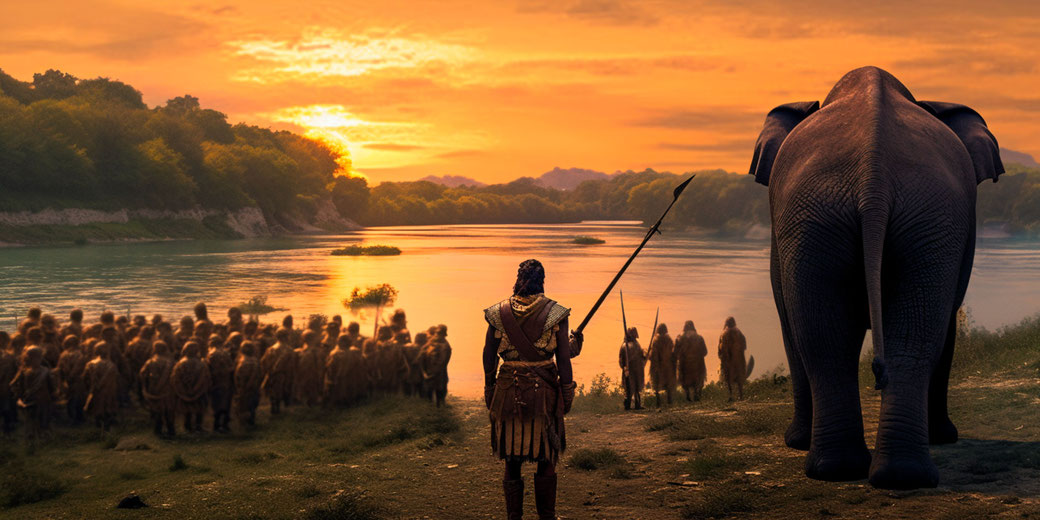How Hannibal did the impossible by sailing war elephants across the raging Rhone River

One of the most iconic episodes of Hannibal Barca's storied career was the crossing of the Rhone River, a venture made all the more legendary by his inclusion of war elephants.
This crossing wasn't just a display of tactical brilliance; it was a statement of intent, a bold declaration to Rome that the Carthaginian general would let no obstacle, natural or man-made, stand in his way.
Hannibal's desire to defeat Rome
In the late 3rd century BC, the ancient Mediterranean world was dominated by two military powers: Rome, the burgeoning republic with ambitions of regional dominance, and Carthage, the established maritime powerhouse of North Africa.
Their rivalry was not just about territorial expansion but also about controlling the vital trade routes that crisscrossed the Mediterranean.
This competition set the stage for a series of conflicts known as the Punic Wars, named after the Latin term for the Carthaginians, "Punici."
Hannibal Barca was born into this world of geopolitical tension. As a young boy, he was said to have sworn an oath to his father, Hamilcar Barca, that he would never be a friend to Rome.
This personal vendetta was fueled by the outcome of the First Punic War, which had ended unfavorably for Carthage.
The terms of the peace treaty, the loss of Sicily, and the heavy war indemnity imposed on Carthage were bitter pills to swallow.
For Hannibal, these were not just political setbacks but personal affronts, shaping his worldview and forging his resolve to challenge Rome's ascendancy.
As he grew and began his military career, Hannibal quickly showcased his tactical brilliance, earning the respect and loyalty of his troops.
But it wasn't just about military maneuvers; Hannibal understood the importance of alliances.
He fostered relationships with various tribes and kingdoms, ensuring a network of support for his campaigns.
This strategy was particularly crucial as he set his sights on the Iberian Peninsula, a region rich in resources and strategically positioned.
But even as he consolidated power in Iberia, Hannibal's gaze was firmly set further north, towards the heart of his sworn enemy.
The strategic importance of the Rhone River
The Rhone River, with its sprawling expanse and swift currents, was more than just a geographical landmark; it was a strategic linchpin in Hannibal's audacious plan to challenge Rome on its home turf.
By choosing to cross the Rhone, Hannibal was signaling a direct route into Roman territory, bypassing the more expected coastal route which would have been easier but also more predictable.
This decision was emblematic of Hannibal's style: always keep the enemy guessing, always be one step ahead.
The Rhone's location was crucial in another sense. To the east lay the formidable barrier of the Alps, a mountain range that few armies dared to traverse, especially with the kind of vast force that Hannibal commanded.
By first crossing the Rhone, Hannibal positioned himself to tackle the Alps while still in the warmer season, a calculated risk that underscored his willingness to face and overcome monumental challenges.
Moreover, the region around the Rhone was inhabited by various Gallic tribes. While some were hostile, others could be persuaded to join Hannibal's cause, either through diplomacy or the sheer awe of seeing an army accompanied by war elephants.
These alliances would prove invaluable, providing local knowledge, additional troops, and resources for the arduous journey ahead.
The problems of the elephants ... and the Gauls
Recognizing the challenges posed by the river's vast expanse and swift currents, Hannibal knew that a successful crossing would require both engineering ingenuity and a deep understanding of the local terrain.
Before embarking on this ambitious endeavor, he sent scouts to survey the river's length, identifying the most suitable points for crossing.
These scouts were tasked with gauging the river's depth, the speed of its currents, and the nature of its banks, all crucial information that would inform the Carthaginian general's strategy.
The presence of war elephants added another layer of complexity to the preparations.
These majestic beasts, while formidable in battle, were not naturally suited to crossing large bodies of water.
To ensure their safe passage, Hannibal's engineers devised innovative solutions, including constructing large rafts reinforced with earth and foliage.
This not only provided a stable platform for the elephants but also created an environment that mimicked solid ground, reducing the animals' anxiety.
The sight of these massive creatures boarding rafts, guided by their North African handlers, must have been a spectacle in itself, a testament to Carthaginian determination and resourcefulness.
Hannibal was also acutely aware of the local Gallic tribes. Anticipating potential confrontations, Hannibal engaged in a mix of diplomacy and shows of strength.
He forged alliances with friendly tribes, securing their support and local knowledge.
At the same time, he demonstrated his army's might to deter any hostile factions, ensuring that his troops could focus on the task at hand without the constant threat of ambush.
Through a combination of strategic planning, engineering prowess, and astute diplomacy, Hannibal laid the groundwork for one of the most audacious feats in military history.

The nail-biting attempt at the crossing
The moment had arrived. With the preparations complete and the challenges ahead well-understood, Hannibal's army stood on the banks of the Rhone, poised to undertake an operation that would be etched in the annals of history.
The river, with its swirling currents and vast breadth, presented a formidable barrier, but the Carthaginian general was undeterred.
He had devised a two-pronged strategy: a portion of his troops would launch a diversionary attack further upstream, drawing the attention of any hostile tribes, while the main force would commence the crossing at the carefully selected point.
As the diversionary force engaged in skirmishes, creating the necessary distraction, the primary contingent began its crossing. Infantry and cavalry waded through shallower sections, while the deeper parts saw the deployment of the specially constructed rafts.
The sight of thousands of soldiers, horses, and equipment making their way across the river must have been awe-inspiring.
But the most breathtaking moment was undoubtedly the crossing of the elephants.
These massive creatures, initially hesitant, were coaxed onto the large rafts. The handlers played a crucial role, using their deep bond with the animals to reassure and guide them.
As the rafts pushed off, some elephants, in their anxiety, jumped into the water but were eventually guided to the opposite bank by their handlers.
The Volcae, a local Gallic tribe, attempted to thwart the crossing, drawn by the diversion upstream.
However, Hannibal's strategy proved effective. The Carthaginians not only repelled the Volcae but also ensured that the majority of the army, including the elephants, made it across the river safely.
How did Rome respond?
Word of Hannibal's audacious Rhone crossing quickly reached Roman ears. The Roman Republic, already wary of Hannibal's intentions, was taken aback by the speed and audacity of his movements.
Initial Roman plans had focused on confronting Hannibal in Iberia, but with the Carthaginian general now rapidly advancing towards the Italian peninsula, a change in strategy was imperative.
Scipio, one of Rome's leading generals, made a swift decision to return to Italy, anticipating Hannibal's likely route.
The psychological impact of Hannibal's rapid advance cannot be understated. Rome, which had long been the dominant power in the Mediterranean, was unaccustomed to being on the back foot.
The very idea that a foreign army, led by a general as cunning and relentless as Hannibal, was marching on Roman soil was deeply unsettling.
This psychological edge gave Hannibal a distinct advantage in the early stages of his Italian campaign.
His victories at Trebia, Lake Trasimene, and Cannae were not just products of his tactical genius but also a result of the demoralizing effect his presence had on the Roman legions.
What do you need help with?
Download ready-to-use digital learning resources
Copyright © History Skills 2014-2025.
Contact via email
With the exception of links to external sites, some historical sources and extracts from specific publications, all content on this website is copyrighted by History Skills. This content may not be copied, republished or redistributed without written permission from the website creator. Please use the Contact page to obtain relevant permission.





